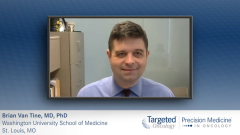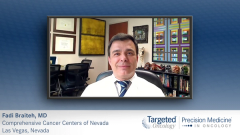
GIST Sequencing in the Adjuvant Setting
Considerations for gastrointestinal stromal tumor (GIST) sequencing in the adjuvant setting.
Brian Van Tine, MD, PhD: I think the mutations seen in GIST [gastrointestinal stromal tumor] cases are interesting. You already brought up exon 9 and exon 11, and we just brought up the resistance mutation, PDGFR. But I think as we get into this more complicated discussion, exon 17 mutations matter. What is your comfort level, and what is your threshold for saying, “This is a complicated GIST case. We should get more people involved?” At what point in the sequencing do you start reaching out for help?
Fadi Braiteh, MD: Well, briefly but very importantly, in the adjuvant setting, even if we do molecular profiling, which is good, it is important to have input from a multidisciplinary team and tertiary center. This is, again, the moment when people would reach out to you. People would see a higher volume and say, “What should I do with that? What’s the input or the consensus, even if there is no randomized trial?” Unfortunately, in metastatic disease, whether it’s recurrent metastatic or metastatic up front, we know from data that the prevalence of molecular profiling of GIST is still suboptimal. We don’t see 100% of these GISTs being profiled. People are sometimes just relying on the diagnosis. They see c-KIT–positive immunohistochemistry from the pathologist. They say, “This is c-KIT–positive.” They’re not distinguishing between the different mutations—exon 9, exon 11 and exon 17. They’re not aware of the others we mentioned. They call it a day. Then we start going down the road of one drug versus the other, and these are costly drugs.
Another thing is, of course, the adverse events are significant, especially when you get to the third line and beyond. We need to make an appeal to do a molecular profile, and if the patient responded and then progressed, they should be resampled and reprofiled. You can get lucky with circulating tumor DNA, but there is no consensus that it can rule out any of the mutations. It rules in, like a new mutation, because there’s a new clone being developed.
Again, the challenge is how much you can sample. I don’t treat GIST specifically—it’s part of a variety of gastrointestinal malignancies that I treat—but I can shed some light about cases where surgeons remove tumors, and 4 samples have 4 different driver mutations that are not overlapping. It’s a really different disease compared to lung cancer, for which, when there is a resistant pattern, it’s consistent, plus or minus…there is a truncal mutation that evolves. It’s very important to resample; or if you rebiopsy, it’s important to work with your interventional radiologist regarding where to put that tip of the needle.
Unfortunately, I still see GIST being radiated once in a while. That’s another thing to educate our colleagues in radiation oncology about. This is not a disease for cytotoxic therapy. Luckily, we have a lot of options, in terms of drugs. And of course, there is some off-label utilization of drugs that are in the guidelines. It’s hit and miss with payers in terms of what you can get back, especially in later lines of therapy beyond the third line. Although now, we have solid options.
Transcript edited for clarity.















































